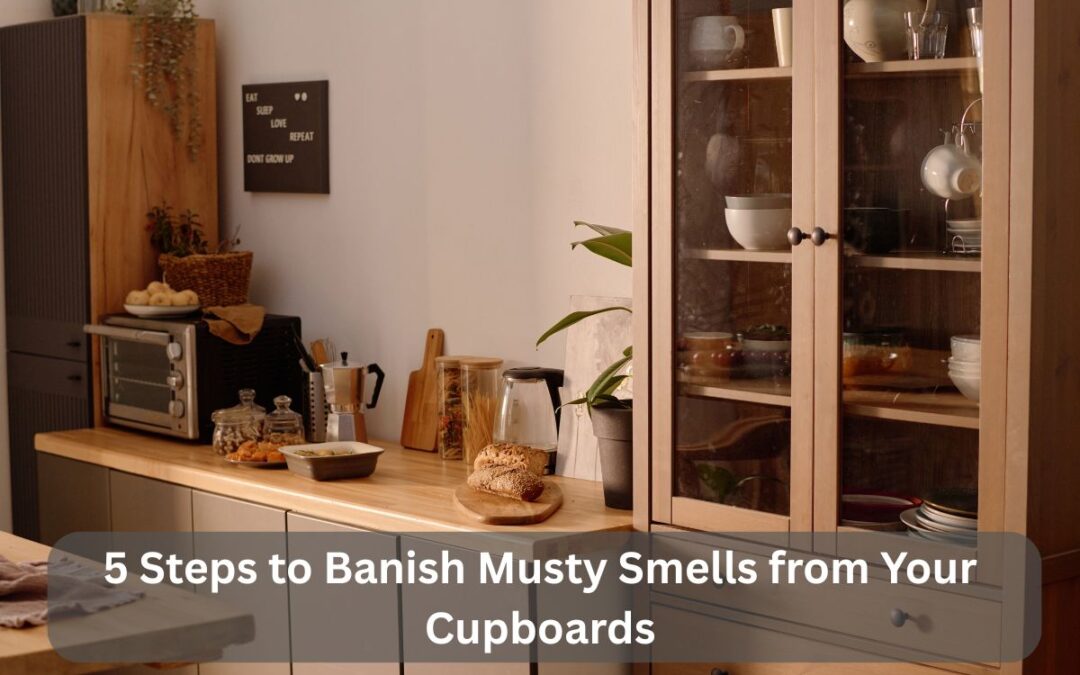A musty smell in cupboards usually results from trapped moisture, poor ventilation, or the buildup of organic materials such as dust, food particles, or mold. Eliminating these odors requires cleaning, deodorizing, and preventive measures to keep cupboards fresh and hygienic.
Key Takeaways
- Musty smells in cupboards are often caused by excess moisture, mold growth, or poor air circulation.
- A step-by-step approach—cleaning, drying, deodorizing, organizing, and preventing—is the most effective way to remove odors.
- Household products such as baking soda, vinegar, and activated charcoal can neutralize lingering smells.
- Long-term prevention includes sealing leaks, improving airflow, and using natural odor absorbers.
- Addressing musty odors quickly helps protect stored items and prevent mold-related health risks.
What Causes Musty Smells in Cupboards?
Before removing the odor, it is important to understand its root causes. Musty smells usually signal the presence of mold spores, mildew, or organic matter breaking down in a damp, dark environment.
- Moisture accumulation: Leaks from plumbing, condensation, or spills can seep into cupboard surfaces.
- Poor ventilation: Stale air trapped inside cupboards accelerates mold and mildew growth.
- Organic residue: Food particles, paper products, or wood fibers provide nutrients for bacteria and fungi.
- Age of materials: Older cupboards, especially wooden ones, may naturally develop odors over time as finishes degrade.
Fast Fact
According to the U.S. Environmental Protection Agency, mold can begin to grow within 24 to 48 hours in damp environments, making moisture control critical to odor prevention.
Step 1: Empty and Inspect the Cupboards
The first step is to clear the space completely. Removing all items helps you identify the source of the smell and prevent contamination of food, dishes, or stored goods.
- Take out all contents, including dishes, canned goods, or linens.
- Inspect shelves, corners, and the back panel for visible mold or stains.
- Check for leaks in pipes or nearby appliances, such as dishwashers or sinks.
- Dispose of expired or damaged items that may contribute to odors.
Example
If a cupboard under the sink smells musty, the culprit is often a slow plumbing leak. Catching this early prevents further damage to wood, drywall, and flooring.
Step 2: Clean Thoroughly with Natural Solutions
Once emptied, cleaning is the foundation for odor removal. Natural cleaning solutions are often more effective and safer than harsh chemicals for regular cupboard care.
Recommended Cleaning Methods
- Vinegar solution: Mix equal parts white vinegar and warm water. Wipe all surfaces, including walls, shelves, and doors. Vinegar neutralizes odors and kills many types of mold spores.
- Baking soda scrub: For stubborn spots, make a paste of baking soda and water. Apply with a soft sponge to lift grime and neutralize odors.
- Mild soap and water: For greasy residues, use dish soap with warm water. Rinse and dry thoroughly afterward.
Important Precautions
- Avoid soaking wooden surfaces to prevent warping.
- Rinse with clean water and dry immediately to remove any cleaning residues.
Important
Always wear gloves and ensure good ventilation when cleaning mold-prone cupboards to reduce exposure to spores.
Step 3: Dry and Deodorize the Space
Moisture is the main driver of musty odors, so thorough drying is essential. After cleaning, ensure the cupboard interior is completely dry before restocking.
Drying Methods
- Leave cupboard doors open for several hours.
- Use fans or a hair dryer on a cool setting for faster drying.
- Place a moisture absorber, such as silica gel or calcium chloride, inside.
Deodorizing Options
- Baking soda: Place an open box or bowl in the cupboard to absorb odors.
- Activated charcoal: Highly effective at trapping smells over several weeks.
- Coffee grounds: Dried coffee grounds can neutralize odors naturally.
Fast Fact
Activated charcoal can absorb up to 200% of its weight in odors and moisture, making it one of the most effective natural deodorizers for closed spaces.
Step 4: Organize and Protect Stored Items
How items are stored in cupboards also affects odor buildup. Proper organization reduces clutter and improves airflow.
- Use airtight containers for food, grains, and spices.
- Avoid storing damp cloths, sponges, or paper inside cupboards.
- Place shelf liners that resist moisture and can be easily replaced.
- Leave small gaps between items and cupboard walls to allow circulation.
Example
Switching from original cardboard food packaging to airtight glass jars can prevent musty odors and reduce the risk of pests.
Step 5: Prevent Future Musty Smells
Long-term freshness depends on maintaining dry, ventilated conditions. Preventive measures include:
- Fix leaks promptly: Regularly check plumbing under sinks and behind appliances.
- Seal cracks: Apply caulking to gaps where water or humidity may enter.
- Improve ventilation: Use cupboard vents, or leave doors slightly open in humid weather.
- Regular maintenance: Clean cupboards seasonally, replacing odor absorbers every few months.
Explain Like I’m 5
Cupboards get smelly when they act like closed boxes where water hides. If you keep them dry, clean, and a little open for air, the smell can’t come back.
Example: Step-by-Step in Action
Imagine a laundry room cupboard where damp towels were stored. The odor grew musty after weeks of poor ventilation.
- After emptying and cleaning with vinegar, the shelves were dried overnight.
- A bowl of baking soda was placed inside, while silica gel packets absorbed moisture.
- Towels were washed, dried fully, and stored in breathable baskets instead of directly on wood shelves.
- The homeowner began leaving the cupboard door slightly open after laundry days.
Within a week, the smell disappeared and did not return.
FAQs
Why do cupboards smell musty even when they look clean?
Moisture and spores can hide in small crevices, wood fibers, or behind panels, creating odors even when surfaces look clean.
Can air fresheners remove musty smells?
Air fresheners only mask odors temporarily. True removal requires cleaning, drying, and neutralizing the underlying cause.
Is mold in cupboards dangerous?
Yes. Mold exposure can trigger allergies, asthma, or respiratory irritation. Even small amounts should be cleaned promptly.
What is the best natural product to keep cupboards fresh?
Baking soda and activated charcoal are the most effective and inexpensive long-term odor absorbers.
How often should cupboards be cleaned to prevent odors?
Deep cleaning once every three to six months, combined with monthly inspections, helps maintain freshness.
The Bottom Line
Musty smells in cupboards are not just unpleasant—they are signs of trapped moisture and potential mold growth. Addressing the problem involves more than masking odors; it requires a systematic approach: empty, clean, dry, organize, and prevent. Household remedies such as vinegar, baking soda, and activated charcoal are effective for eliminating existing smells, while preventive strategies like sealing leaks and improving ventilation ensure the odors don’t return.
By following these five steps, you can restore freshness to your cupboards, protect stored items, and maintain a healthier indoor environment.

As the chief content writer, Hassan Al Sarker works as a professional kitchen-based content creator at Kitchen Liker.
In addition to reviewing the content published on Kitchen Liker, he ensures that it is accurate, relevant, and helpful. As a result, all the reviews and information published at Kitchen Liker are neutral and userfriendly.
Hassan Al Sarker has a bachelor’s degree in Hotel and Tourism Management From the Newyork University. Before joining Kitchen Liker, he was a contributor at Kitchen Club, United States.

